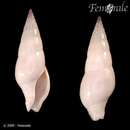en
names in breadcrumbs


Die Keulenschnecken (Clavatulidae) sind eine monophyletische Familie kleiner bis mittelgroßer Gehäuseschnecken, die ausschließlich im Meer beheimatet sind. Sie wurden bis zum Jahr 2011 zu den Schlitzturmschnecken (Turridae) innerhalb der Überfamilie Conoidea gezählt.
Die Arten der Familie Clavatulidae haben mittelgroße bis große, spindelförmige Gehäuse mit länglichem, spitzen und hohen Gewinde. Die Gehäusemündung ist oval und meist weiß. Der Kern des Operculums sitzt medio-lateral. Der Siphonalkanal kann recht kurz – so etwa bei Pusionella compacta – oder auch mäßig lang und leicht gekrümmt sein – so bei Fusiturris undatiruga. Der Analsinus variiert stark von sehr flach bis recht tief. Die äußere Lippe der Gehäusemündung kann leicht eingebogen und an der Seite gesägt sein. Die untere Nahtrampe ist meist wohl entwickelt. Das Schneckenhaus ist je nach Art sehr unterschiedlich skulpturiert und kann recht glatt sein – so bei Gemmuloborsonia colorata – oder längs fein gerippt und quer gestreift. Die Zahnformel der stenoglossen Radula ist 1-(1-R-1)-1.
Die Keulenschnecken sind in warmen Meeren weltweit verbreitet und fehlen in kalten Gewässern. Ein Verbreitungsschwerpunkt ist der Indopazifik, doch sind die Vertreter der Gattung Clavatula im Atlantischen Ozean zu finden, und zwar vorzugsweise an der Westküste Afrikas. Hier ist auch Pusionella nifat anzutreffen, deren Verbreitungsgebiet bis an die algerische Mittelmeerküste reicht. Im Mittelmeer tritt zudem die Art Fusiturris similis auf.
Die Ernährungsgewohnheiten sind bisher nur bei wenigen Clavatulidae beobachtet worden, doch dienen bei allen untersuchten Arten Vielborster (Polychaeta) als Beutetiere. Die mit einer Giftdrüse verbundenen Radulazähne weisen die Schnecken als Räuber aus, die ihre Beute stechen und vergiften. Turricula nelliae frisst viele verschiedene Polychaeten, doch vor allem Lagis koreni und Vertreter der Gattungen Poecilochaetus und Prionospio.[1] Auch Turricula javana frisst Vielborster, insbesondere aus den Gattungen Poecilochaetus und Marphysa.[2]
John Edward Gray stellte 1853 um die Gattung Clavatula eine Unterfamilie auf, die lange Zeit innerhalb der Pfeilzüngler (Toxoglossa) zu den Schlitzturmschnecken (Turridae) gezählt wurde. Rosenberg erhob 1998 auf Grundlage einer kladistischen Analyse dieses Taxon zu einer eigenen Familie, die auch nach Auffassung anderer Autoren (Kantor, Sysoev) mit den Schlitzturmschnecken keine monophyletische Gruppe bildet.
Derzeit werden 14 rezente und 2 fossile Gattungen innerhalb dieser Familie unterschieden:[3]
Nicht mehr zu diesem Taxon gezählt werden folgende Gattungen:
Folgende Gattungen sind nicht mehr als solche anerkannt:
Die Keulenschnecken (Clavatulidae) sind eine monophyletische Familie kleiner bis mittelgroßer Gehäuseschnecken, die ausschließlich im Meer beheimatet sind. Sie wurden bis zum Jahr 2011 zu den Schlitzturmschnecken (Turridae) innerhalb der Überfamilie Conoidea gezählt.
Clavatulidae is a taxonomic family of sea snails, marine gastropod mollusks in the superfamily Conoidea.[3] The family is not well differentiated morphologically.
Clavatulidae was raised, based on cladistic analysis, from subfamily to the family level by Rosenberg in 1998. It is no longer regarded as a subfamily of Turridae by several malacologists (Kantor, Sysoev).[2][4][5] This family has no subfamilies.
This family consists of species with a medium-sized to rather large, fusiform shell. The oblong, pointed spire is rather high. The aperture is oval and mostly white. The operculum has a medio-lateral nucleus. The siphonal canal varies between rather short (e.g. Pusionella compacta) to moderately long and slightly incurved (e.g. Fusiturris undatiruga). The anal sinus varies from very shallow to rather deep. The outer lip can be slightly incurved and serrated on its side. The subsutural ramp is usually well developed. The sculpture of the shell in this family shows various forms, going from a rather smooth surface (e.g. Gemmuloborsonia colorata) to being finely ribbed longitudinally and striated transversally. The stenoglossan radula has the formula 1-(1-R-1)-1 [4][6]
Genera in the family Clavatulidae include:
Species from family Clavatulidae are omnivores, predators and scavengers.[8]
Clavatulidae is a taxonomic family of sea snails, marine gastropod mollusks in the superfamily Conoidea. The family is not well differentiated morphologically.
Clavatulidae was raised, based on cladistic analysis, from subfamily to the family level by Rosenberg in 1998. It is no longer regarded as a subfamily of Turridae by several malacologists (Kantor, Sysoev). This family has no subfamilies.
Clavatulidae est une famille de mollusques gastéropodes marins de l'ordre des Neogastropoda.
Selon World Register of Marine Species (16 mars 2016)[1] :
Fusiturris duchasteli flexiplicata
Clavatulidae est une famille de mollusques gastéropodes marins de l'ordre des Neogastropoda.
Clavatulidae is een familie van weekdieren uit de klasse van de Gastropoda (slakken).
Clavatulidae is een familie van weekdieren uit de klasse van de Gastropoda (slakken).
Clavatulidae é uma família de gastrópodes da ordem Hypsogastropoda.[1]
Gêneros na família Clavatulidae incluem:
Clavatulidae é uma família de gastrópodes da ordem Hypsogastropoda.